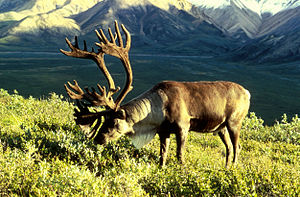The caribou, also known as reindeer and wild reindeer in Europe and Eurasia, of the same species—Rangifer tarandus— is a medium size ungulate of the Cervidae family which also includes wapiti, moose and deer. The North American range of this Holarctic animal extends from Alaska, through the Yukon, the Northwest Territories, Nunavut, into the boreal forest and south through the Canadian Rockies and the Columbia and Selkirk Mountains. The caribou is a specialist that is well adapted to cooler climates with hollow-hair fur that covers almost all of its body including its nose, and provides insulation in winter and flotation for swimming. Two major subspecies in North America, the R. t. granti and the R. t. groenlandicus form large herds and undertake lengthy seasonal migrations from birthing grounds, to summer and winter feeding grounds in the tundra and taiga. The migrations of R. t. granti Porcupine herd are among the longest of any terrestrial mammal. The George River caribou herd (GRCH) of the R. t. caribou subspecies in the Ungava area—once the largest Rangifer tarandus herd in the world—declined to 74 131 animals—a drop of up to 92%. In 2011 the combined Beverly/Ahiak herd in the Northwest Territories and Nunavut, had approximately 124 000 caribou— at least a 50% drop since 1994; the Western caribou herd had 325 000 animals and the Qamanirjuaq caribou herd which is relatively stable had declined from 496 000 in 1994 to 345 000 in 2008. The meta-population of the more sedentary subspecies R. t. caribou or Woodland caribou spans the boreal forest from the Northwest Territories to Labrador. They are shy animals whose main food source is arboreal lichens of the mature forests and mainly live in marshes, bogs, lakes, and river regions. Since it takes hundreds of years for a biomass of tree lichen to be adequate to sustain boreal woodland caribou populations, deforestation is a major factor in the decline of their numbers. The historic range of the boreal woodland caribou covered over half of present-day Canada, stretching from Alaska to Newfoundland and Labrador and as far south as New England, Idaho, and Washington. The smallest subspecies in North America, the Peary Caribou is found in the High and Low Arctic, in the Northwest Territories—particularly, Banks Island and in Nunavut—particularly, Baffin Island.Caribou can a reach speed of 60–80 km/h (37–50 mph). Young caribou can already outrun an Olympic sprinter when only a day old.Ongoing human development of caribou habitat has caused populations of Woodland caribou to disappear from their original southern range. In particular, the caribou was extirpated in many areas of eastern North America in the beginning of the 20th century. Woodland caribou was designated as threatened in 2002. Environment Canada reported in 2011 that there were approximately 34 000 boreal caribou in 51 ranges remaining in Canada (Environment Canada, 2011b).The caribou's favourite winter food is fruticose deer lichen. Seventy percent of the diet of woodland caribou consists of arboreal lichen which take hundreds of years to grow and are therefore only found in mature forests. Barren-ground, Porcupine and Peary caribou live in the tundra while the shy Woodland caribou, prefers the boreal forest.Although there are many variations in colour and size, Canadian Geographic magazine states that in general, Barren-ground caribou have larger antlers than the woodland caribou subspecies. Barren-ground caribou have large distinguishing white patches of fur that extend beyond the neck onto the back, a white muzzle and a face that is darker than the rest of the body. Their fur is sandy-beige in winter and light brown in summer. The Woodland caribou have a wider more compact body and wider antlers. The coat is a rich dark brown in summer and dark grey in winter. Both the barren-ground and woodland caribou often have white "socks" above their hooves. On average the male weighs 90–110 kg (200–240 lb) and measures .9–1.7 m (3.0–5.6 ft) in shoulder height. The Woodland caribou are the largest and the Peary caribou the smallest. The largest Alaskan male caribou can weigh as much as 310 kilograms (680 lb).Both sexes grow antlers, though in a some Woodland caribou populations, females lack antlers completely. Antlers are larger in males.

Estado de conservación
LC
Sistema de estado de conservación
iucn3.1
Sinónimo
reindeer in Europe and Eurasia



Kommentieren
0